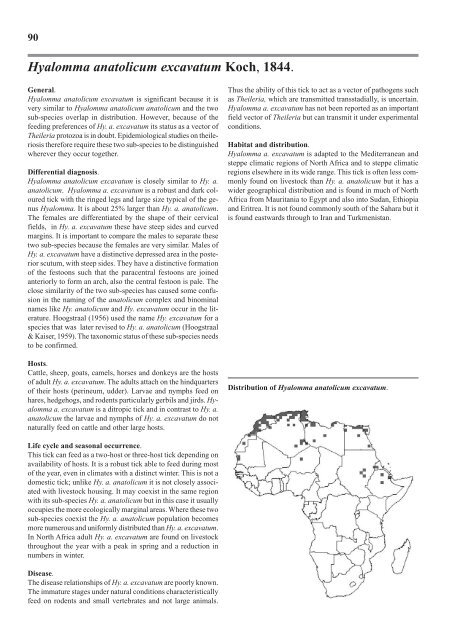Ticks of Domestic Animals in Africa - Alan R Walker - Science Writer
Ticks of Domestic Animals in Africa - Alan R Walker - Science Writer
Ticks of Domestic Animals in Africa - Alan R Walker - Science Writer
Create successful ePaper yourself
Turn your PDF publications into a flip-book with our unique Google optimized e-Paper software.
90<br />
Hyalomma anatolicum excavatum Koch, 1844.<br />
General.<br />
Hyalomma anatolicum excavatum is significant because it is<br />
very similar to Hyalomma anatolicum anatolicum and the two<br />
sub-species overlap <strong>in</strong> distribution. However, because <strong>of</strong> the<br />
feed<strong>in</strong>g preferences <strong>of</strong> Hy. a. excavatum its status as a vector <strong>of</strong><br />
Theileria protozoa is <strong>in</strong> doubt. Epidemiological studies on theileriosis<br />
therefore require these two sub-species to be dist<strong>in</strong>guished<br />
wherever they occur together.<br />
Differential diagnosis.<br />
Hyalomma anatolicum excavatum is closely similar to Hy. a.<br />
anatolicum. Hyalomma a. excavatum is a robust and dark coloured<br />
tick with the r<strong>in</strong>ged legs and large size typical <strong>of</strong> the genus<br />
Hyalomma. It is about 25% larger than Hy. a. anatolicum.<br />
The females are differentiated by the shape <strong>of</strong> their cervical<br />
fields, <strong>in</strong> Hy. a. excavatum these have steep sides and curved<br />
marg<strong>in</strong>s. It is important to compare the males to separate these<br />
two sub-species because the females are very similar. Males <strong>of</strong><br />
Hy. a. excavatum have a dist<strong>in</strong>ctive depressed area <strong>in</strong> the posterior<br />
scutum, with steep sides. They have a dist<strong>in</strong>ctive formation<br />
<strong>of</strong> the festoons such that the paracentral festoons are jo<strong>in</strong>ed<br />
anteriorly to form an arch, also the central festoon is pale. The<br />
close similarity <strong>of</strong> the two sub-species has caused some confusion<br />
<strong>in</strong> the nam<strong>in</strong>g <strong>of</strong> the anatolicum complex and b<strong>in</strong>om<strong>in</strong>al<br />
names like Hy. anatolicum and Hy. excavatum occur <strong>in</strong> the literature.<br />
Hoogstraal (1956) used the name Hy. excavatum for a<br />
species that was later revised to Hy. a. anatolicum (Hoogstraal<br />
& Kaiser, 1959). The taxonomic status <strong>of</strong> these sub-species needs<br />
to be confirmed.<br />
Hosts.<br />
Cattle, sheep, goats, camels, horses and donkeys are the hosts<br />
<strong>of</strong> adult Hy. a. excavatum. The adults attach on the h<strong>in</strong>dquarters<br />
<strong>of</strong> their hosts (per<strong>in</strong>eum, udder). Larvae and nymphs feed on<br />
hares, hedgehogs, and rodents particularly gerbils and jirds. Hyalomma<br />
a. excavatum is a ditropic tick and <strong>in</strong> contrast to Hy. a.<br />
anatolicum the larvae and nymphs <strong>of</strong> Hy. a. excavatum do not<br />
naturally feed on cattle and other large hosts.<br />
Life cycle and seasonal occurrence.<br />
This tick can feed as a two-host or three-host tick depend<strong>in</strong>g on<br />
availability <strong>of</strong> hosts. It is a robust tick able to feed dur<strong>in</strong>g most<br />
<strong>of</strong> the year, even <strong>in</strong> climates with a dist<strong>in</strong>ct w<strong>in</strong>ter. This is not a<br />
domestic tick; unlike Hy. a. anatolicum it is not closely associated<br />
with livestock hous<strong>in</strong>g. It may coexist <strong>in</strong> the same region<br />
with its sub-species Hy. a. anatolicum but <strong>in</strong> this case it usually<br />
occupies the more ecologically marg<strong>in</strong>al areas. Where these two<br />
sub-species coexist the Hy. a. anatolicum population becomes<br />
more numerous and uniformly distributed than Hy. a. excavatum.<br />
In North <strong>Africa</strong> adult Hy. a. excavatum are found on livestock<br />
throughout the year with a peak <strong>in</strong> spr<strong>in</strong>g and a reduction <strong>in</strong><br />
numbers <strong>in</strong> w<strong>in</strong>ter.<br />
Disease.<br />
The disease relationships <strong>of</strong> Hy. a. excavatum are poorly known.<br />
The immature stages under natural conditions characteristically<br />
feed on rodents and small vertebrates and not large animals.<br />
Thus the ability <strong>of</strong> this tick to act as a vector <strong>of</strong> pathogens such<br />
as Theileria, which are transmitted transstadially, is uncerta<strong>in</strong>.<br />
Hyalomma a. excavatum has not been reported as an important<br />
field vector <strong>of</strong> Theileria but can transmit it under experimental<br />
conditions.<br />
Habitat and distribution.<br />
Hyalomma a. excavatum is adapted to the Mediterranean and<br />
steppe climatic regions <strong>of</strong> North <strong>Africa</strong> and to steppe climatic<br />
regions elsewhere <strong>in</strong> its wide range. This tick is <strong>of</strong>ten less commonly<br />
found on livestock than Hy. a. anatolicum but it has a<br />
wider geographical distribution and is found <strong>in</strong> much <strong>of</strong> North<br />
<strong>Africa</strong> from Mauritania to Egypt and also <strong>in</strong>to Sudan, Ethiopia<br />
and Eritrea. It is not found commonly south <strong>of</strong> the Sahara but it<br />
is found eastwards through to Iran and Turkmenistan.<br />
Distribution <strong>of</strong> Hyalomma anatolicum excavatum.


